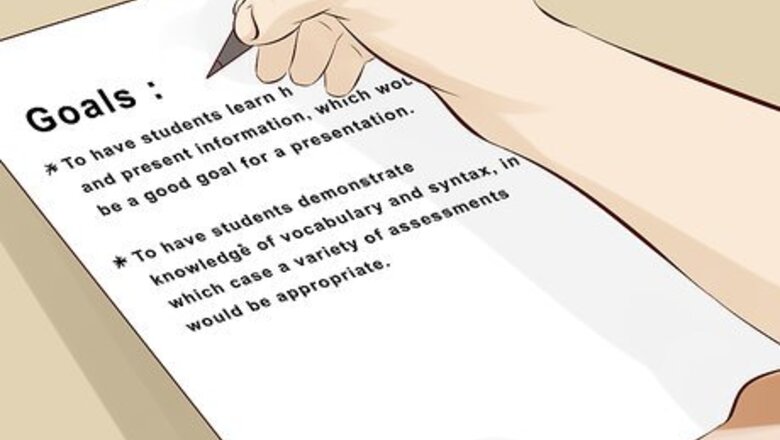
views
Creating a Rubric
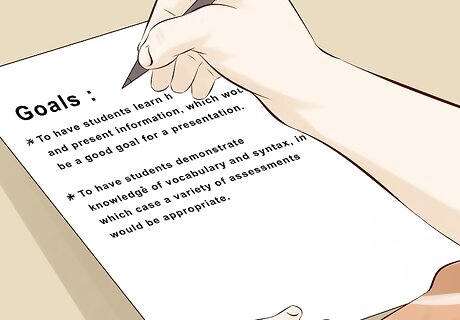
Define a goal for your assessment or assignment. The goal is what you want your students to achieve through the assessment. Having a goal helps you to decide on criteria and the type of assessment or assessments you want to use. For instance, your goal might be to have students learn how to organize and present information, which would be a good goal for a presentation. Alternatively, maybe your goal is to have students demonstrate knowledge of vocabulary and syntax, in which case a variety of assessments would be appropriate. Other goals might be to establish that students can respond to questions in their second language or to evaluate how well students can think on their feet.
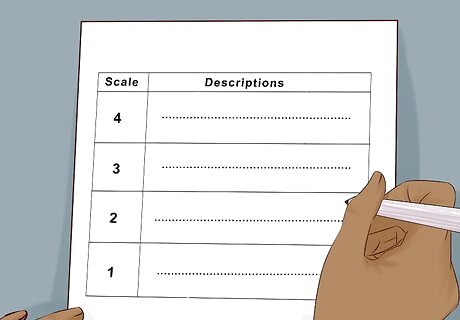
Decide on a scale. The scale you use is up to you. If you want a scale that has room for more nuance, try 1-9. If you are trying to keep things simple, try a scale that goes from 1-4 or even a basic scale like excellent, pass, and fail. The detail in your scale depends on what you're using the evaluation for. If you're trying to determine a letter grade, you'll likely need a more detailed scale. If you're just trying to figure out where someone needs improvement, a less detailed scale should be fine. The scale should run from failing on the low end to doing very well on the high end.
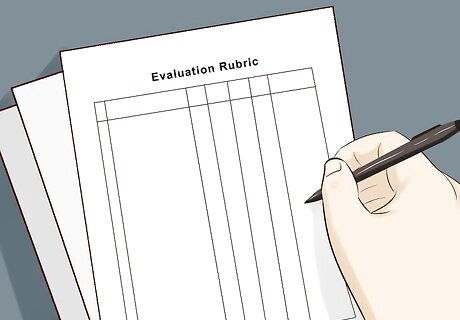
Make a rubric sheet you can use to grade each student. List the scale along the top of the page by number. Along the side, list each criteria you're evaluating, using a shortened form of the criteria to fit it on the page. Make a copy for each student you plan to evaluate. Have a second page on hand where you list the description for each criteria and each number along the top.
Establishing the Criteria You're Assessing

Look for how well students use syntax and vocabulary. Syntax is how sentences are structured. Like every other language, English follows rules when it comes to sentence structure, and you can evaluate how well students follow those rules. You can also look at how well students are able to choose the appropriate word, based on both denotation and connotation. Denotation is the strict dictionary definition of the word. Connotation is the social and emotional context behind the word. For instance, "avoid" and "escape" are considered synonyms, and therefore, have similar denotations. However, they have different connotations, as "escape" tends to mean getting out of a bad situation while "avoid" can mean not being in the situation in the first place. When establishing your scale for this criteria, you could have things like "Uses syntax and vocabulary fluently" on the high end and "Has trouble forming sentences and choosing words" on the low end.
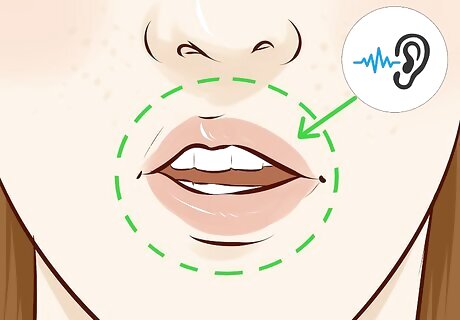
Check for pronunciation. Pronunciation is another important criteria of spoken language. It refers to how well a person articulates the word and whether they are able to combine words when necessary into contractions. Listen to see how easy you can understand the person. Pay particular attention to words that have difficult spellings, as that makes pronunciation harder. For your scale, you could use "Pronounces words clearly, uses contractions appropriately" on the high end and "Is very difficult to understand, doesn't use contractions" on the low end. An average student might be "Pronounces more than half of the words well, uses contractions occasionally."
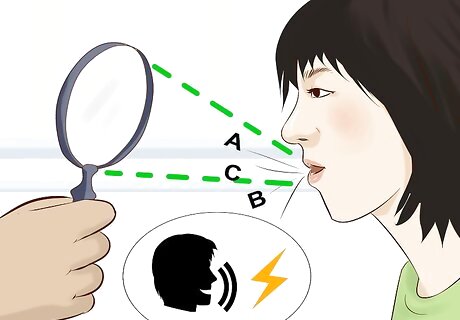
Pay attention to coherence and fluency. With this criteria, check how the student is able to string thoughts together. Part of this component is speed, as a more fluent person is able to speak faster. That doesn't mean the student needs to speed through their speech or dialogue. However, it does mean they should be able to connect ideas together in a reasonable time so the listener is able to follow along. Essentially, this criteria is checking to see if the student knows more than just vocabulary. Can they put words together into sentences and sentences together into paragraphs? For this scale, you might use "Speech flowed together and was easy to understand as a whole" for the high end, and "Speech was disconnected, student had trouble piecing thoughts together." An average student might be "Has good grasp of vocabulary; can put sentences together with a little difficulty."

Watch interactions to assess the ability to think and respond in English. This criteria also tests how well your students listen and comprehend. It requires students to move beyond a prepared speech and actually come up with their own responses. For this scale, you might have "Able to respond to questions with accuracy" for the top of the scale and "Had trouble understanding and replying to questions" for the bottom. For the middle, you might have "Could understand what was being asked but could only give rote answers."
Choosing Assessment Tasks

Try a 1-on-1 discussion to evaluate conversational skills. A simple way to evaluate your students is to have them sit down with you for a short discussion. Have a set of prepared questions ahead of time, so that you're asking each student the same questions. The questions can be simple, such as: How are you doing today? What's the weather like outside? or What are your plans for the weekend? The questions could also be themed, such as a weather theme: Is it sunny out? When did it rain last? What was the weather like yesterday? and What's your favorite kind of weather? Try giving your students a selection of topics to prepare for ahead of time, and then choosing 1 or 2 for the exam.

Assign students a presentation to assess formal speaking skills. This type of assessment gives students a chance to prepare their speech ahead of time. However, they still must communicate effectively to you and the other students. You can let students choose their topic or assign one to them. The topics can be simple, such as describing how to do something or telling a personal story.
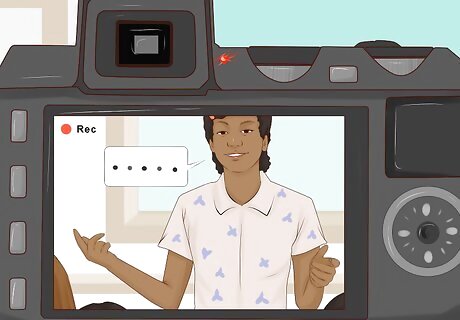
Let students prepare a speaking video to evaluate presentation skills. This method is similar to a classroom presentation, but it takes some of the pressure off the student. Try this method to see how a student is progressing throughout a semester, particularly in online classes. Let the student select a topic or assign one. Have a set time limit for the video. Establish the basic points you'd like to see in the video, such as introduction to the topic, a discussion of its relevance, and a conclusion. Be as specific as you can to put students at ease.
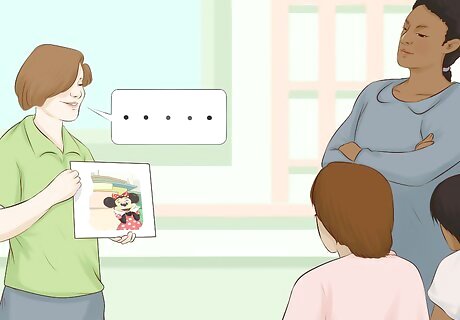
Ask for a description of an image or images to test a wide range of skills. Present the student with an image or a set of images. Tell the student to describe what's in the image. To increase the difficulty, ask the student to connect a series of images. For instance, you can ask the student to put the images in an order and then explain why they chose that order. You could also ask the student to compare and contrast the pictures.
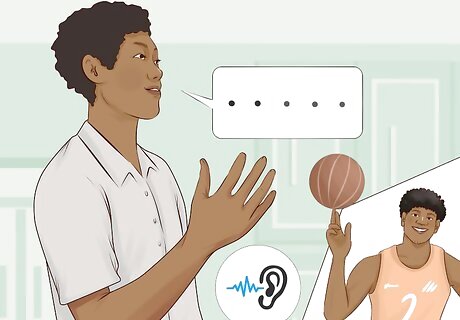
Request that a student put a story in their own words for retention. This method requires that your students be able to retain information, re-organize it, and synthesize it into their own words. It also requires clear pronunciation. For instance, give them a story to read before class. Ask them to retell it to you for the evaluation. Alternatively, give students a text to read for a set period of time in class, then ask each student to come retell it to you privately.

Give students text to read aloud to test pronunciation and emphasis. You can ask one student to read a passage, or you can ask several students to read a dialogue. This testing method doesn't require students to come up with their own language, but it does require them to know how to say things and what tone of voice to use.
Doing the Assessment
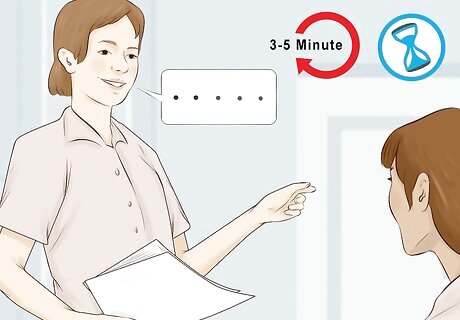
Decide on the time guidelines for each task you want to evaluate. Your students should know ahead of time how much speaking they'll be required to do. Assigning time periods for each task allows them to prepare more thoroughly. For instance, you may want to set a goal of a 5 minute presentation or a 3-4 minute discussion.

Provide an example of the task to prepare students. Show students example of what you expect them to do for your class. You can use videos for this purpose. Go through the rubric on each example to show how you'd score each example, explaining as you go along. This shows students exactly what you want and helps put them at ease when it comes time for them to do it. You want students to be as relaxed as possible for the evaluation, so they can do their best.

Have students use the rubric for one example. After showing a couple of examples and how you'd grade them, have the students do it. Show them an example, and let each student use your scale to score each criteria. Then, go over the example together. This activity allow students to see exactly what you want, and it can help them improve their own presentation or speaking skills when it comes time to do it themselves.

Use the rubric to evaluate each student. As the student performs the requested task, mark a number on the scale for each criteria you've selected. If you've created a detailed rubric, you should be able to do this task mostly objectively. Once you have a number for each criteria, you can take an average of the numbers to assign a grade to the student, if you need to assign a grade. For instance, if you have the numbers 8, 7, 5, 8, and 6 for scores, add them together (34) and divide by how many criteria you have (5) to get 6.8. Use that number to assign a grade.

Have students evaluate themselves after they do the assessment. This assessment isn't to punish to student. Rather, it's to get them thinking about their own speaking skills and how they can improve. When they are self-evaluating, they are more likely to show progress. For instance, at the end of a presentation, ask the student to take a few minutes to discuss how they did.


















Comments
0 comment